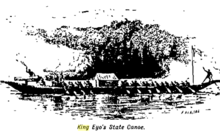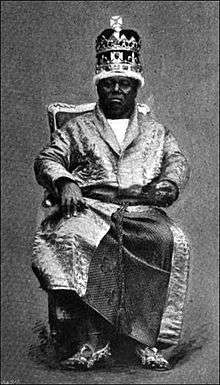Akwa Akpa
| Akwa Akpa | |
|---|---|
| City state | |
|
Picture of Old Calabar Factories from HM Stanley's book "The Congo and the founding of its free state; a story of work and exploration (1885)" | |
 Southeastern states, including Calabar | |
| Coordinates: 4°57′N 8°19′E / 4.950°N 8.317°ECoordinates: 4°57′N 8°19′E / 4.950°N 8.317°E |
Akwa Akpa, known to European colonists as Old Calabar or Duke Town, was an Efik city-state that flourished in the 19th century in what is now southeastern Nigeria. Although it is now absorbed into Nigeria, traditional rulers of the state are still recognized. The state occupied what is now the modern city of Calabar.
Origins and society
The Efik are a subgroup of the Ibibio people.[1] They speak a language in the Obolo subgroup of the Niger–Congo language group.[2] They had become a power on the coast of the Bight of Benin by the early 18th century, by which time the Duke and Eyamba families were their leaders. They were settled in large, fortified villages along the waterways, in a loose federation with no paramount ruler, living by fishing and farming. The largest settlements were Ikot Itunko, Obutong and Iboku Atapka. In the 19th century, the British renamed these as Creek Town, Old Town and Duke Town.[3]
Religion
The traditional Efik religion considers that Abasi created the universe. One tradition says that Abasi's wife Atai persuaded him to let two of their children, a daughter and son, settle on the earth. They were not allowed to breed, but disobeyed this injunction and became the ancestors of the Efik people. Another version says that Abasi created two people, and did not allow them to breed. When they disobeyed this order, in punishment Anasi let loose death on the earth.[4]
The religion places importance on paying tribute to the village ancestors, particularly those who achieved high rank, since they can affect the fortunes of the living for good or bad. The earth deity Ala is appeased through the Ogbom ceremony, which makes children plentiful and increases the harvest.
Some Ekips belong to the Ekpe secret society. They made detailed wood carvings, masks, and accouterments that are considered complex works of art. Ekip sacred ceremonies include drumming and music as important elements.[1]
Slave trade
The coast in this region was named "Calabar" by the Portuguese explorer Diogo Cao.[5] His reason for choosing this name is unknown, since it was not used by the Efik people.[6] The city of Akwa Akpa was founded by Efik families who had left Creek Town, further up the Calabar river, settling on the east bank in a position where they were able to dominate the slave trade with European vessels that anchored in the river. They soon became the most powerful people in the region.[7] Akwa Akpa, also known as Duke Town to the British, became a center of the slave trade, where slaves were exchanged for European goods.[8]
The main ethnic group taken out of Calabar as slaves were the Igbo, although they were not the most populous ethnicity in the area.[9] Most slave ships that transported slaves from Calabar were English; around 85% of these ships being from Bristol and Liverpool merchants.[10] Conditions were brutal. In 1767, six British slaving vessels were lying in the Calabar river at a time when the people of Duke Town and Old Town were feuding. By prearrangement with the leaders of Duke Town, the leaders of Old Town were invited on board for a conference to settle the dispute, with guarantees of their safety. They were seized, with some kept as slaves and a few handed over to Duke Town, where they were executed.[5]
Later history
.jpg)
The slave trade was banned by a British decree of 1808, and slavery was banned in all British territories in 1833. Traders from other nations, such as Spain, continued to buy slaves at Calabar until 1842. In that year, King Eyamba V of Duke Town and King Eyo of Creek Town signed a treaty agreeing to stop trading slaves.[5] With the suppression of the slave trade, palm oil and palm kernels became the main exports.[11]
In 1846 a Christian mission was established by the United Presbyterian Church between Duke Town and Henshaw town, with the support of King Eyo. The mission was headed by Rev. Hope Masterton Waddell with support from Hugh Goldie, who wrote an account of Calabar in his 1890 book Calabar and its Mission.[12] That year the chiefs requested British protection for Calabar, but the reply from Lord Palmerston, received in 1848, was that it was not necessary or advisable to grant the request. The British said they would treat the people of Calabar favorably if they would give up their practice of human sacrifice.[13] At the time, it was common for wives and slaves of an important man to be sacrificed upon his death.[5]
On the death of King Eyamba in 1847, it was proposed that King Eyo become sole ruler, which the British favored. However, the Duke Town leaders did not agree, and selected Archibong Duke as the new king. In 1850, both kings agreed to suppress human sacrifice.

British influence continued to grow, as did acceptance of Christianity.[5] The chiefs of Akwa Akpa placed themselves under British protection in 1884.[11] King Archibong III of Calabar Kingdom was crowned in 1878 with a regalia sent directly by Queen Victoria of United Kingdom.[14]
From 1884 until 1906 Old Calabar was the headquarters of the Niger Coast Protectorate, after which Lagos became the main center.[11] Now called Calabar, the city remained an important port shipping ivory, timber, beeswax, and palm produce until 1916, when the railway terminus was opened at Port Harcourt, 145 km to the west.[15]
Independent rulers

Rulers of the city state, and successors in the traditional state, were:[16]
- Ekpenyong Offiong Okoho (1786–1805)
- Ekpenyong Effiom Okoho Eyamba III (1805–1814)
- Effiom Edem Ekpo Effiom I Eyamba IV (1814–1834)
- Edem Ekpenyong Offiong Okoho Eyamba V (1834–1847)
- Effiom Okoho Asibong I Ekpo Minika (May 1849 - February 1852)
- Ededem Effiom II (April 1852 - August 1858)
- Eyo Asibong II (March 1859 - August 1872)
- Edem Asibong III Eyamba VIII (1872 - May 1879)
- Orok Edem Eyamba IX (1880–1896)
- Eyo Etinyin
Later Obongs
In 1903 the British made an agreement with the Efik Kings that they would no longer use title of King (Edidem), but instead as titular rulers would have the title Obong of Calabar.[17]
- Obong Edem Effiom Edem (January 1903 - 1906)
- Obong Asibong IV
- Obong Asibong V (1956 -)
Efik rulers
In December 1970 it was agreed that a single ruler should represent the Efik people, rather than two (one for Creek Town and one for Duke Town), with the ruler alternated between the two communities.[18]
- Edidem David James Henshaw V (1970–1973)
- Edidem Esien Ekpe Oku V (1973–1980)
- Edidem Bassey Eyo Ephraim Adam III (1980–1987)
- Edidem Otu Ekpenyong Effa IX (1987–1989)
- Edidem Boco Ene Mkpang Cobham V (1989–1999)[18]
- (vacant 1999 - 2001)[19]
- Edidem Nta Elijah Henshaw (2001–2004)[20]
- Edidem Ekpo Okon Abasi Otu (2008 -)
- Etinyin Eyo
See also
References
- 1 2 "Eket Information". University of Iowa. Archived from the original on December 4, 2010. Retrieved 2010-10-17.
- ↑ "Obolo". Ethnologue. Retrieved 2020-10-17. Check date values in:
|access-date=(help) - ↑ William H. Taylor (1996). Mission to Educate: A History of the Educational Work of the Scottish Presbyterian Mission in East Nigeria, 1846-1960. BRILL. p. 31ff. ISBN 90-04-10713-4. Retrieved 2020-10-17. Check date values in:
|access-date=(help) - ↑ Molefi K. Asante, Ama Mazama (2009). Encyclopedia of African religion, Volume 2. SAGE. p. 230. ISBN 1-4129-3636-5. Retrieved 2020-10-17. Check date values in:
|access-date=(help) - 1 2 3 4 5 Hugh Goldie (1890). Calabar and Its Mission. Edinburgh: Oliphant, Anderson and Ferrier. ISBN 1-4097-2795-5.
- ↑ G. I. Jones (2001). The trading states of the oil rivers: a study of political development in Eastern Nigeria. James Currey Publishers. p. 15ff. ISBN 0-85255-918-6.
- ↑ Arthur Glyn Leonard (2009). The Lower Niger and Its Tribes. BiblioBazaar, LLC. pp. 21–22. ISBN 1-113-81057-2.
- ↑ "The Middle Passage". National Great Blacks in Wax Museum. Retrieved 2010-09-02.
- ↑ Chambers, Douglas B. (2005). Murder at Montpelier: Igbo Africans in Virginia. Univ. Press of Mississippi. p. 22. ISBN 1-57806-706-5.
- ↑ Sparks, Randy J. (2004). The Two Princes of Calabar: An Eighteenth-century Atlantic Odyssey. Harvard University Press. p. 39. ISBN 0-674-01312-3.
- 1 2 3 "CALABAR (or OLD CALABAR)". 1911 Encyclopædia Britannica, Volume V04, Page 962. Retrieved 2010-09-02.
- ↑ Gerald H. Anderson (1999). "Goldie, Hugh". Biographical dictionary of Christian missions. Wm. B. Eerdmans Publishing. ISBN 0-8028-4680-7. Retrieved 2010-10-20.
- ↑ [Countess Ilchester, ed. The Life and Letters of Lady Sarah Lennox, 1745–1826, London: John Murray, 1901]
- ↑ "Coronation of an African King". The New York Times. 6 November 1878. Retrieved 2010-10-17.
- ↑ "History of Calabar". The African Executive. Retrieved 2010-09-02.
- ↑ "Nigeria: Traditional polities". Rulers.Org. Retrieved 2010-09-02.
- ↑ TATABONKO OROK EDEM (April 23, 2008). "The Obongship Dispute in Calabar: A Rejoinder". Kwenu.com. Retrieved 2010-09-02.
- 1 2 "Culture & Society". Creek Town (Iboku Esit Edik) Foundation. Retrieved 2010-09-02.
- ↑ "Royal Fathers: Their Power, Influence, Relevance...". ThisDay. 2003-08-31. Retrieved 2010-09-02.
- ↑ Anietie Akpan (March 3, 2004). "Kingmakers give Henshaw 14 days to abdicate throne". The Guardian. Retrieved 2010-09-02.
External links
| Wikisource has the text of the 1911 Encyclopædia Britannica article Calabar. |
| Wikimedia Commons has media related to Calabar. |
